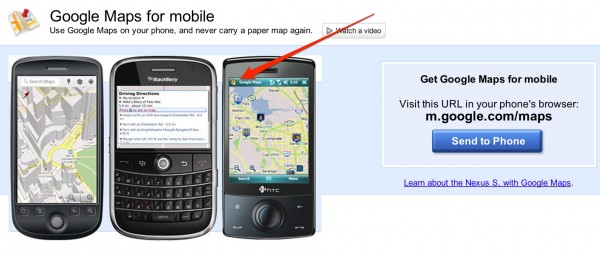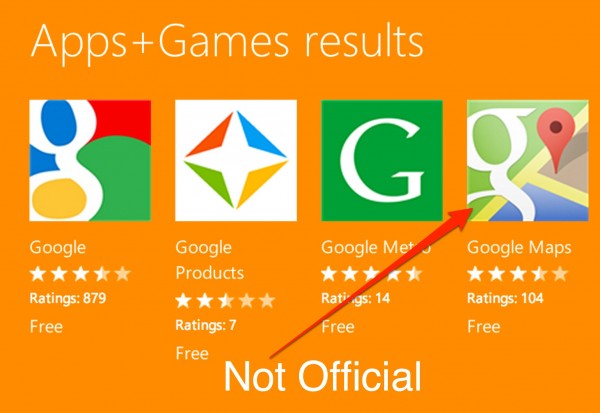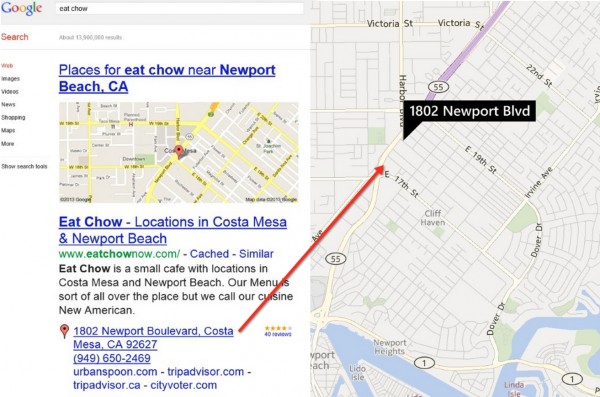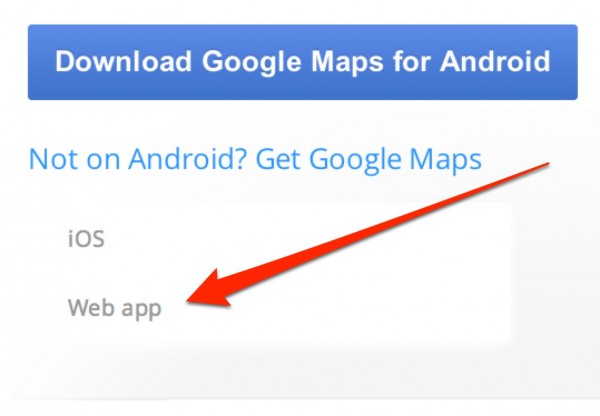The Strange Explanation Of Why Windows Phone Users Lost Access To Google Maps
On Friday, Windows Phone users supposedly found themselves unable to access Google Maps. But Google said it made no sudden change on its end to cause this. What happened? It seems likely many people simple noticed for the first time long-standing redirection that Google had in place for those not using Android or iOS devices. Windows Phone […]
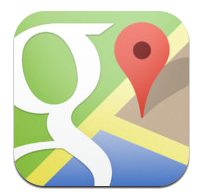 On Friday, Windows Phone users supposedly found themselves unable to access Google Maps. But Google said it made no sudden change on its end to cause this. What happened? It seems likely many people simple noticed for the first time long-standing redirection that Google had in place for those not using Android or iOS devices.
On Friday, Windows Phone users supposedly found themselves unable to access Google Maps. But Google said it made no sudden change on its end to cause this. What happened? It seems likely many people simple noticed for the first time long-standing redirection that Google had in place for those not using Android or iOS devices.
Windows Phone User? No Google Maps For You!
To recap briefly, some Windows Phone users started reporting (as covered by The Verge) that they were unable to reach Google Maps using the Internet Explorer web browser on their phones. They got redirected instead to the Google home page.
Google initially suggested (as covered by Gizmodo) that this was because Internet Explorer on Windows Phone wasn’t a WebKit-based browser and so Google Maps wouldn’t work for it.
Google later added (as covered by The Next Web) that it was redirecting people on Windows Phone devices because of this incompatibility, but Google said this would soon change, since the latest version of Internet Explorer for Windows Phone was now apparently Google Maps-capable:
Google sent us the same statement that The Next Web received, which says:
We periodically test Google Maps compatibility with mobile browsers to make sure we deliver the best experience for those users.
In our last test, IE mobile still did not offer a good maps experience with no ability to pan or zoom and perform basic map functionality. As a result, we chose to continue to redirect IE mobile users to Google.com where they could at least make local searches. The Firefox mobile browser did offer a somewhat better user experience and that’s why there is no redirect for those users.
Recent improvements to IE mobile and Google Maps now deliver a better experience and we are currently working to remove the redirect. We will continue to test Google Maps compatibility with other mobile browsers to ensure the best possible experience for users.
I’ll revisit that statement in a moment, but first, several publications keep saying that Google Maps was never supported for Windows smartphone users. That’s not the case.
Google Used To Support Windows Mobile Devices
Consider this screenshot of the Google Maps For Mobile page from mid-2011:
That third device? That’s a Windows mobile device. Google even had specific instructions for those wanting to use Windows mobile devices to reach Google Maps:
Given the above, let’s put to rest what I keep reading, that Google Maps has never supported Windows phones. It clearly has, as far back as 2010 and at least officially through June 2012, according to the Internet Archive.
Windows Mobile Vs. Windows Phone
Ah, but are we talking Windows Mobile being supported but not Windows Phone? That’s a Windows Mobile device being shown (I used to use one of these regularly). Windows Mobile was the predecessor to Microsoft’s current Windows Phone mobile operating system.
It seems that it is Windows Mobile that this page was referring to. Google told me that the page was for its old Windows Mobile app that’s no longer supported.
Apparently, going to the m.google.com/maps URL would have triggered a request to download the app to a Windows Mobile device.
What if you went to the regular version of Google Maps in your Windows Mobile browser? Well, years ago Windows Mobile was my main phone, and I used Google Maps all the time. I seem to remember using it through my browser, not through an app.
Which Version Of IE For Windows Phone “Failed” & When?
As for Windows Phone, apparently this page was never updated to reflect whether Windows Phone was supported or not despite the release of that operating system in early 2010.
Windows Phone 7.5 shipped with Internet Explorer 9; Windows Phone 8 with Internet Explorer 10. Was it an issue with one or both of these browsers? That leads us back to this part of Google’s statement:
We periodically test Google Maps compatibility with mobile browsers to make sure we deliver the best experience for those users.
In our last test, IE mobile still did not offer a good maps experience with no ability to pan or zoom and perform basic map functionality. As a result, we chose to continue to redirect IE mobile users to Google.com where they could at least make local searches.
The statement tells us that some version of IE was found lacking by Google at some point in the past, so Google put a redirect into place. Was it IE9 for mobile? IE10 for mobile? Some minor version of either of these? Google hasn’t said.
I asked Google when the test was done on IE, and when the redirect based on that failed test was put into place. Google said it couldn’t share when the test was done and that the redirect was in place for “some time.”
That doesn’t provide much clarity.
Why Didn’t Users Encounter The Redirect Before?
One odd thing is what long-time Microsoft watcher Mary Jo Foley pointed out on CNET:
In response to a query from me, a Google representative said the redirection for Windows Phone users seeking access to Google Maps via IE in the browser has “always” been in place. I cannot definitively prove this is wrong, but it seems to me that I’ve used Google Maps via IE on my Windows Phone at least once in the past year-plus.
Indeed, I’ve used various Windows Phone devices for about two years, and I’m virtually certain I’ve accessed Google Maps through my web browser on those phones without encountering a redirect.
Most puzzling, though, is that if the redirect has been out there for some time — let’s assume at least weeks, if not months — then why did all these Windows Phone users suddenly encounter problems?
Google’s not sure but tells me: “We did not make any changes in the last few days.” [NOTE: See my postscript below that explains how Google does seem correct, that this isn’t a new change just one that’s been recently noticed].
Looks Bad – More Windows Phone Support Would Help
However it happened, it’s very bad timing. It comes just after Google basically won the anti-trust investigation that the US Federal Trade Commission had ben conducting. It gives the impression that Google decided to cut-out those on Microsoft’s mobile platform perhaps to help hurt Microsoft’s already-weak mobile market share.
It also comes on the heels of Google being accused by Microsoft of blocking a YouTube app for Windows Phone.
One thing that would help would be if Google built an actual Google Maps app for Windows Phone, similar to the work it did to make one for Apple’s iOS operating system.
Google’s argument in these cases tends to be that it shuns Windows Phone because of low market share (effectively what it told me about not providing Google Voice for Windows Phone). The grand total of apps published by Google for Windows Phone? One:
It’s a fair enough argument in one sense, but it’a also convenient one to help prevent a rival operating system from growing. It also means that when you search for official Google apps, you instead end up with fake or unofficial ones like this:
Fake or unofficial apps are also a security issue. The lack of a Google Voice app, for example, means that some are potentially providing a third-party app with their Google Account details.
The bottom line is that there are Google users on Windows Phone. They shouldn’t have to feel like second-class Google citizens just because they don’t want to use Google’s Android operating system or because they’re not part of the iOS crowd that Google still feels is worthwhile to cater to.
As for this weekend’s mystery, stay tuned. Being a weekend, it’s likely harder for Google to fully investigate what happened. But here’s hoping that Windows Phone users get stable access back to the Google Maps they want.
Postscript
I wrote the above story when I was away from my home office, and I didn’t have any of my Windows Phone devices to test. Now that I’m back (it’s 4:00 am ET, on January 6), I’ve tried some things with both my Lumia 900 Windows Phone 7.5 and my HTC 8X Windows Phone 8.
First, the redirection happens on both, if I try to go to maps.google.com. Instead, I get routed to google.com. This does not happen, as reports have said, if I try to go to maps.google.co.uk.
How IE Leads From Google To Bing Maps
Second, I remarked earlier how I was sure I’ve been to Google Maps before on these phones without encountering redirection, similar to what Mary Jo Foley was remarking on. But after testing, I’m not so sure.
Consider what might be a typical situation. Someone does a search from the Google home page using Internet Explorer on Windows Phone, then gets a local listing complete with a local address that’s a link. As it turns out, the address isn’t normally a link, not in Safari on iOS, not in Chrome on Android.
It’s a link on Windows Phone because IE seems to turn addresses into links, which in turn lead to Bing Maps:
It’s possible that people have been getting routed into Bing Maps rather than Google Maps in this way (in part because Google itself fails to direct them there) and so never encountered the redirection that Google says has long existed.
As far as they knew, they were going from Google into what they might have assumed was Google Maps. It’s not like you can immediately tell a big difference.
This Didn’t Just Happen To “Many” People
More important, I went back to The Verge forum discussion that seems to have kicked all this off. It begins with a single person remarking:
Anyway seeing to current relationships between the 2 companies I don’t expect it to come. A pity because I needed it recently because bing/nokia maps are not as good. Another way users are being set aside. :(
The person doesn’t say that this is new. In fact, it comes across as something he may never have tried before. He doesn’t sound like a regular Google Maps user on Windows Phone but rather someone who tried this as a one-off thing and noticed it was happening.
You then have various other people reporting that they see it happening, too. But none of them seem to be saying that it was new. Most of those commenting seem to be people who never tried this before and thus clearly aren’t regular Google Maps users, not at least through Windows Phone. There are a few who remark that the redirection has been this way for months.
In the end, the only thing that really seems to have changed is that a bunch of people who likely never went to Google Maps directly in their Windows Phone devices before just tried to for the first time and discovered the redirection, which probably was long-standing.
Next, things got magnified when The Verge reported on its own forum discussion with this lead:
Google Maps has never officially been supported on Windows Phone, but today many users have reportedly been cut off entirely. Frustrated owners report that trying to visit the web version of Google’s popular service results in them being redirected to the company’s main website.
Many users have been cut-off? Frustrated owners? Again, it really seems like a number of people who never used Google Maps directly from their Windows Phones heard about this in the forum, tried it themselves and confirmed it. And to say they’re frustrated? Since so many clearly never used Google Maps this way before, how were they suddenly frustrated not to be able to do something they never did before?
I’m not sure that this all entirely originated out of The Verge. I can also see WMPoweruser reporting on it happening from a tip it received. But that tip probably came as word of what was being discussed in The Verge forum went around.
Google Didn’t Change Things…
In summary, I don’t think Google changed anything here. I just think few realized it was this way before, including myself. It certainly struck me by surprise when I first read reports of it. I thought it was a new change myself.
But It Should Fix “Google Maps For Mobile”
Still, remember that m.google.com/maps page I mentioned way above, the long-standing URL that Google used for those seeking advice on using Google Maps via mobile devices. Consider what happens if you try accessing that on various phones:
The picture above shows, from left-to-right, what appears on my Galaxy Nexus Android Phone, my iPhone 5 iOS Phone, my Nokia 900 Windows Phone 7.5 and my HTC 8X Windows Phone 8.
The Android phone redirects the URL to a page pitching Google’s Android apps. The iPhone also gets redirected but to a page pitching iOS apps from Google. The Windows 7.5 phone gets redirected to a page for all “other” mobile devices, which lists these apps:
Google Maps isn’t one of the supported “web” apps, which I’ll get back to. But how about that last phone, my Windows Phone 8? It gets redirected to the Google Maps For Android page, which seems due to the fact that on that phone, my setting was to deliver desktop version of pages, rather than mobile versions.
The lack of a Google Maps web app reflects Google’s inattentiveness to browser-based support for mobile devices. I think Google gave up long ago on caring about people accessing Google Maps through a mobile web browser. And why would it?
Why Google’s Neglected Google Maps For Mobile Browsers
Until this year, Google Maps was baked into the Maps application with iOS. No one on that platform really needed to turn to the browser-based version. Similarly, Android phones had access to the Google Maps app.
The last major update to Google Maps for mobile browsers — prior to Google being kicked off Apple Maps — was back in May 2011. Google added some new features, only for Android and iOS users despite later saying in its post about the change:
Google Maps for mobile browsers is platform independent – you will always get a consistent experience and the latest features without needing to install any updates, no matter what phone you use.
The Google Maps For Mobile page continued to promise support for multiple platforms through June 23 of last year. Around June 29, that page was quietly changed to be devoted entirely to the Google Maps For Android app.
Google finally seemed to care again about Google Maps for mobile browsers after it was dropped as the provider for Apple Maps in iOS 6 last September. Suddenly, it started pitching Google Maps through the browser through a special promo and tour for iOS users. In October, Google added Street View photography to Google Maps For Mobile – at least for those using iOS and Android.
Now, I think Google is playing catch-up. It was so busy propping up Google Maps For Mobile for iOS users, to tide things over until it could release its own Google Maps app for iOS, that it hasn’t revisited the situation with other platforms.
Google probably hasn’t bothered to check on Windows Phone’s ability to support Google Maps for some time, so unnecessary redirection clearly exists. Meanwhile, Google hasn’t restored a much-needed overview page to advise those who aren’t iOS or Android users about their mobile options for using Google Maps
This inattentiveness is also why you get something as dumb as this showing on that Google Maps For Android page:
“Not on Android?” No problem Google says — use the web app! The web app which is simply a link to maps.google.com, which in turn gets redirected for those on Windows Phone (and likely many other phones other than Android and iOS) because Google doesn’t really try to support them any longer.
I don’t think Google did anything new or sudden to try and injure the Windows Phone platform in terms of Google Maps support. Rather, it’s simply not cared about Windows Phone or other mobile platforms — including Android and iOS — having decent browser-based access for ages, except for the brief window of September through December of last year, when suddenly, many iOS users had no alternative but to use it.
NOTE: I’ve updated the lead of this story from the original, to reflect my findings covered in the postscript. For those who care, the original lead was:
On Friday, Windows Phone users found themselves unable to access Google Maps. Google says it made no sudden change on its end to cause this, but some of Google’s explanations for the blockage don’t add up.
The explanations didn’t add up when it seemed this was a new thing impacting many people. But the closer look that I’ve covered in the postscript makes the explanation seem reasonable. Of course, if it turns out there are other sources out there actually documenting this as a new shift, that changes things. But I’ve looked, and I can’t find them so far.
Contributing authors are invited to create content for Search Engine Land and are chosen for their expertise and contribution to the search community. Our contributors work under the oversight of the editorial staff and contributions are checked for quality and relevance to our readers. The opinions they express are their own.
Related stories
